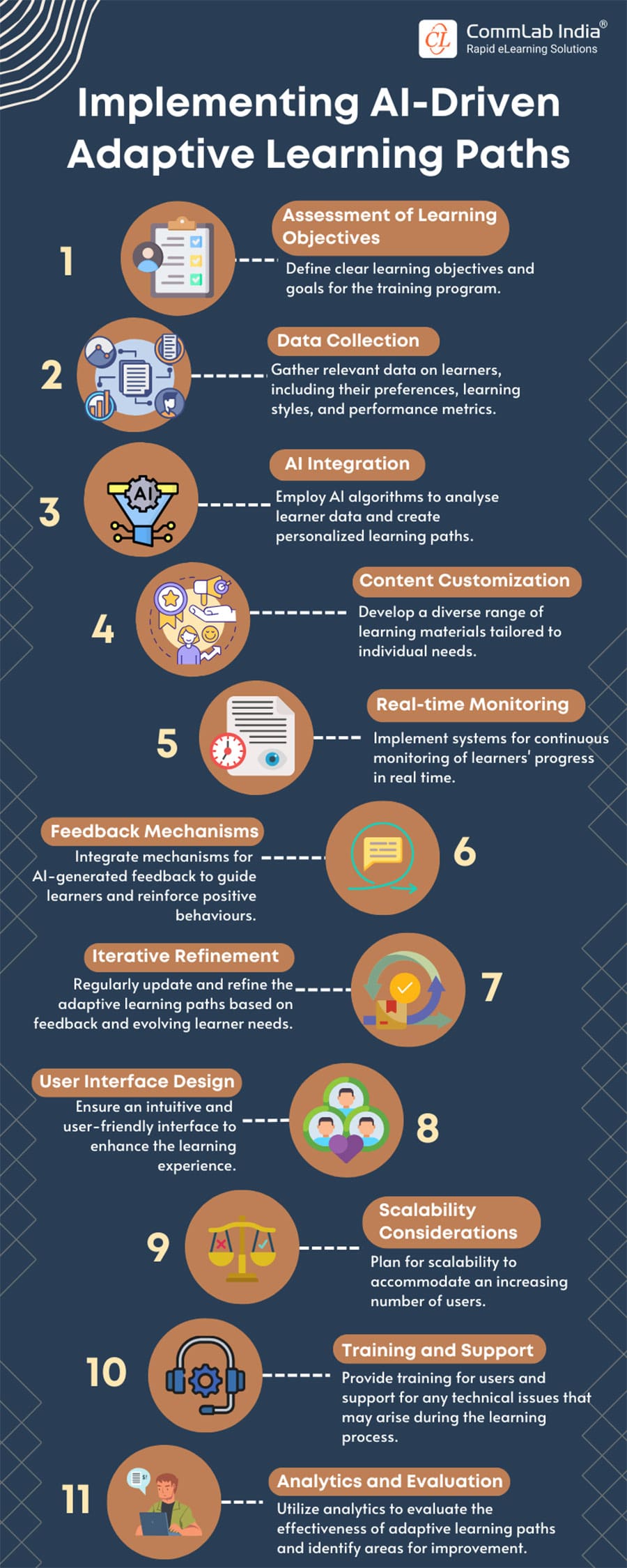How to Implement AI-Driven Adaptive Learning Paths [Infographic]
![How to Implement AI-Driven Adaptive Learning Paths [Infographic] How to Implement AI-Driven Adaptive Learning Paths [Infographic]](https://blog.commlabindia.com/hubfs/blogs/how-implement-ai-driven-adaptive-learning-paths-info.jpg)
The use of artificial intelligence (AI) in corporate training is a game-changer. It offers a one-stop solution to organizations to ensure successful training and achieve their business goals. AI significantly improves productivity, efficiency, and learner engagement to maximize the training ROI. However, when we talk about AI, it's not just a singular aspect that improves corporate training, there are plenty of them. From personalized learning to automated assessments and feedback to data analytics, the application of AI can be seen everywhere.
In this blog, we’ll particularly talk about AI-driven adaptive learning paths. Firstly, we’ll understand what AI-driven adaptive learning paths are and their benefits, and then get to know about the steps of implementing AI-driven adaptive learning paths and strategies for effective implementation.
Are you ready? Let’s begin.
What are AI-Driven Adaptive Learning Paths?
AI-driven adaptive learning paths refer to the use of artificial intelligence to customize the learning journey for each learner. They modify the content, pace, and difficulty of instruction to each learner's unique learning needs and preferences. This AI-backed training approach optimizes the learning process and provides learners with the most relevant and engaging materials at the right time.
→ Download Now: The AI Revolution: Redefining Generative AI for Dynamic L&D Teams
Benefits of AI-Driven Adaptive Learning Paths
There are a plethora of benefits offered by AI-driven adaptive learning paths. Some of them are given below:
- Personalized learning experiences cater to individual learning styles and preferences.
- Improve learner engagement and motivation through tailored content.
- Enhance learning outcomes as AI adjusts difficulty levels based on learner progress.
- Real-time feedback from AI fosters a deeper understanding of concepts.
- Adaptive learning paths accommodate diverse learner needs, promoting inclusivity.
- Continuous monitoring and analysis identify and address learning gaps promptly.
- Efficient use of time and resources with targeted content delivery.
- Facilitation of self-paced learning, allowing learners to progress at their own speed.
- Data-driven insights help trainers know about the learners’ strengths and weaknesses.
Tips for Effective Implementation of AI in Corporate Training
Implementing AI in corporate training can enhance learning experiences, improve efficiency, and drive better outcomes. Here are some tips to effectively incorporate AI into your corporate training:
Identify Training Needs
- Conduct a thorough training need analysis to understand the specific skill and knowledge gaps within your organization.
- Match the identified gaps with areas where AI can add value and address specific training needs.
Define Clear Objectives
- Clearly define the learning objectives and goals you want to achieve with AI-driven training.
- Align these objectives with overall business goals to ensure relevance and impact.
Customize Learning Paths
- Use AI to personalize learning paths based on individual employee profiles, roles, and performance.
- Adaptive learning systems can tailor content to the specific needs and learning styles of each employee.
Utilize Predictive Analytics
- Implement predictive analytics to forecast future skill requirements and proactively address potential skill gaps.
- Use data insights to refine and optimize training programs over time.
Solicit Continuous Feedback
- Implement systems that provide real-time feedback on AI performance.
- Incorporate the feedback and recommendations received to improve the AI-driven training.
Monitor and Evaluate
- Regularly monitor the effectiveness of AI-driven training programs.
- Collect feedback from learners and use analytics to measure the impact on performance and skill development.
Compliance and Security
- Ensure that your AI-powered training complies with relevant regulations and addresses security concerns.
- Safeguard sensitive employee data and maintain compliance with privacy standards.
Involve the Stakeholders
- Involve stakeholders in the AI implementation process, ensuring their buy-in and addressing any concerns.
- Provide training on how to effectively use AI tools and platforms.
The Process of Implementing AI-Driven Adaptive Learning Paths
To Sum It Up!
AI-driven adaptive learning paths signify a major change in the way corporate training is provided. It offers a variety of benefits such as increased productivity, efficiency, and training ROI. It’s a futuristic approach that drives learner engagement and participation to help organizations make the most of their training initiatives and achieve their goals. Read the eBook below to know how you can leverage generative AI to level up your corporate training.







![Ways to Tackle Employee Onboarding Challenges Head-On [Infographic]](https://blog.commlabindia.com/hubfs/blogs/employee-onboarding-challenges-solutions-info.jpg)